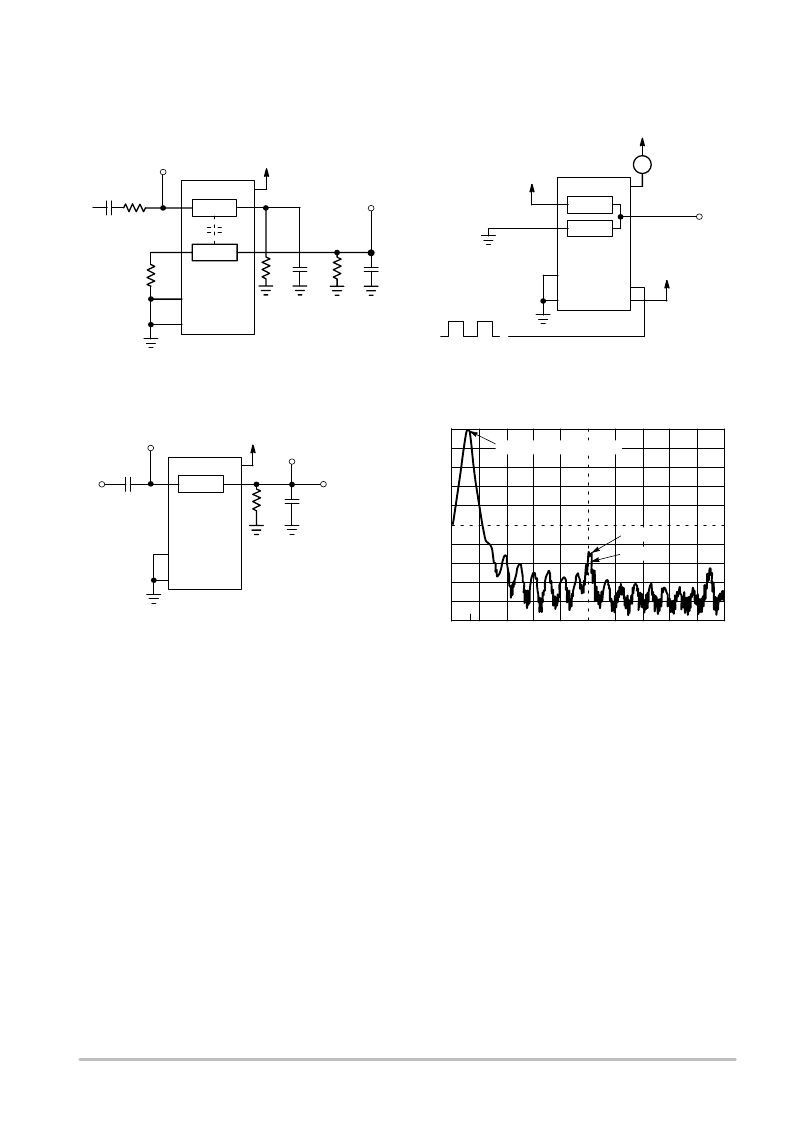- 您現(xiàn)在的位置:買賣IC網(wǎng) > PDF目錄358962 > LVXT8053 (ON SEMICONDUCTOR) Analog Multiplexer / Demultiplexer High−Performance Silicon−Gate CMOS PDF資料下載
參數(shù)資料
| 型號: | LVXT8053 |
| 廠商: | ON SEMICONDUCTOR |
| 英文描述: | Analog Multiplexer / Demultiplexer High−Performance Silicon−Gate CMOS |
| 文件頁數(shù): | 9/12頁 |
| 文件大小: | 171K |
| 代理商: | LVXT8053 |

MC74LVXT8053
http://onsemi.com
9
R
L
Figure 12. Crosstalk Between Any Two
Switches, Test SetUp
Figure 13. Power Dissipation Capacitance,
Test SetUp
Figure 14a. Total Harmonic Distortion, Test SetUp
Figure 14b. Plot, Harmonic Distortion
0
10
20
30
40
50
100
1.0
2.0
3.125
FREQUENCY (kHz)
d
60
70
80
90
FUNDAMENTAL FREQUENCY
DEVICE
SOURCE
ON
6
8
16
C
L
*
*Includes all probe and jig capacitance
OFF
R
L
R
L
V
IS
R
L
C
L
*
V
OS
f
in
0.1 F
ON/OFF
6
8
16
V
CC
CHANNEL SELECT
NC
COMMON O/I
OFF/ON
ANALOG I/O
V
CC
A
11
V
CC
ON
6
8
16
V
CC
0.1 F
C
L
*
f
in
R
L
TO
DISTORTION
METER
*Includes all probe and jig capacitance
V
OS
V
IS
APPLICATIONS INFORMATION
The Channel Select and Enable control pins should be at
V
CC
or GND logic levels. V
CC
being recognized as a logic
high and GND being recognized as a logic low. In this
example:
V
CC
= +5V = logic high
GND = 0V = logic low
The maximum analog voltage swing is determined by the
supply voltages V
CC
. The positive peak analog voltage
should not exceed V
CC
. Similarly, the negative peak analog
voltage should not go below GND. In this example, the
difference between V
CC
and GND is five volts. Therefore,
using the configuration of Figure 15, a maximum analog
signal of five volts peaktopeak can be controlled. Unused
analog inputs/outputs may be left floating (i.e., not
connected). However, tying unused analog inputs and
outputs to V
CC
or GND through a low value resistor helps
minimize crosstalk and feedthrough noise that may be
picked up by an unused switch.
Although used here, balanced supplies are not a
requirement. The only constraints on the power supplies are
that:
V
CC
GND = 2 to 6 volts
When voltage transients above V
CC
and/or below GND
are anticipated on the analog channels, external Germanium
or Schottky diodes (D
x
) are recommended as shown in
Figure 16. These diodes should be able to absorb the
maximum anticipated current surges during clipping.
相關(guān)PDF資料 |
PDF描述 |
|---|---|
| LW101 | INFRARED LAMP LED |
| LW141 | BLUE OVAL LAMP LED |
| LW160Z | GREEN OVAL LAMP LED |
| LW191 | RED OVAL LAMP LED |
| LW3333 | Hyper 3 mm (T1) LED, Non Diffused Hyper-Bright LED |
相關(guān)代理商/技術(shù)參數(shù) |
參數(shù)描述 |
|---|---|
| LVXZ161284 WAF | 制造商:Fairchild Semiconductor Corporation 功能描述: |
| LVY12241 | 制造商:LIGITEK 制造商全稱:LIGITEK electronics co., ltd. 功能描述:SUPER BRIGHT ROUND TYPE LED LAMPS |
| LVY12243 | 制造商:LIGITEK 制造商全稱:LIGITEK electronics co., ltd. 功能描述:SUPER BRIGHT ROUND TYPE LED LAMPS |
| LVY12343-PF | 制造商:LIGITEK 制造商全稱:LIGITEK electronics co., ltd. 功能描述:SUPER BRIGHT ROUND TYPE LED LAMPS |
| LVY13433-PF | 制造商:LIGITEK 制造商全稱:LIGITEK electronics co., ltd. 功能描述:SUPER BRIGHT OVAL TYPE LED LAMPS |
發(fā)布緊急采購,3分鐘左右您將得到回復(fù)。